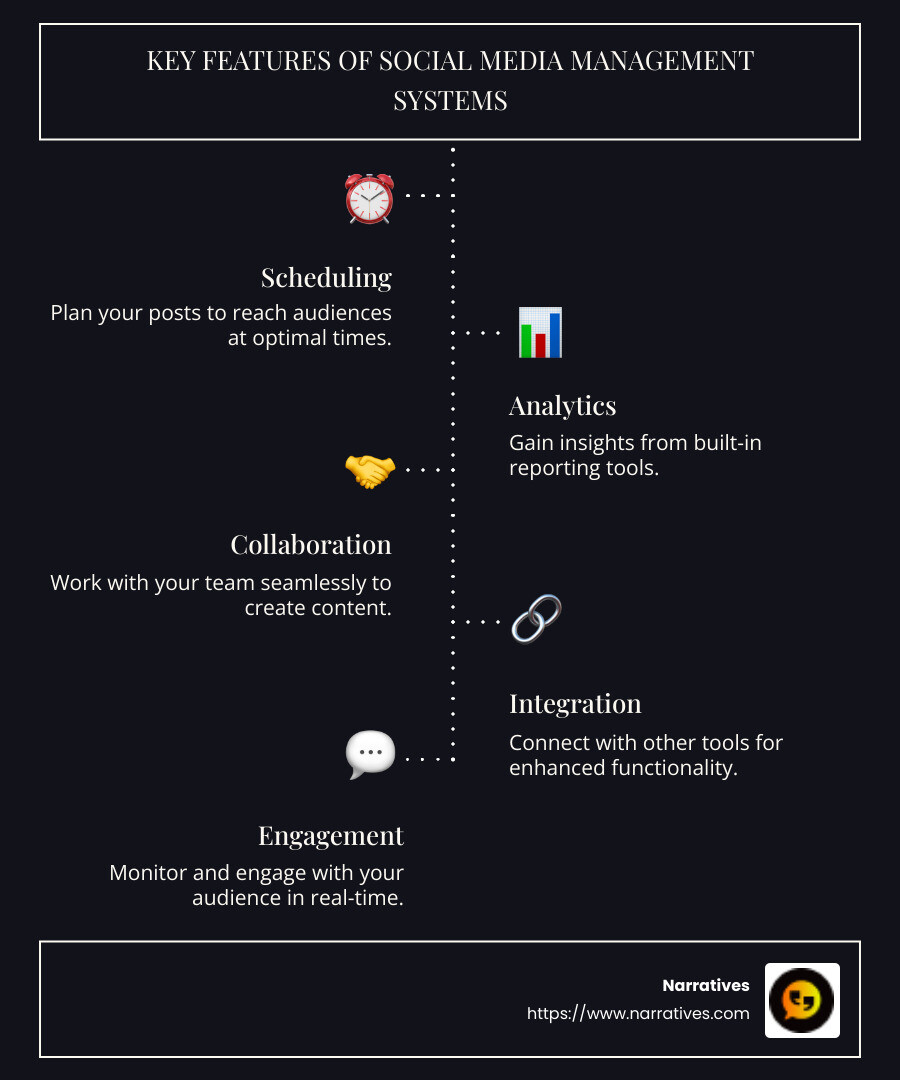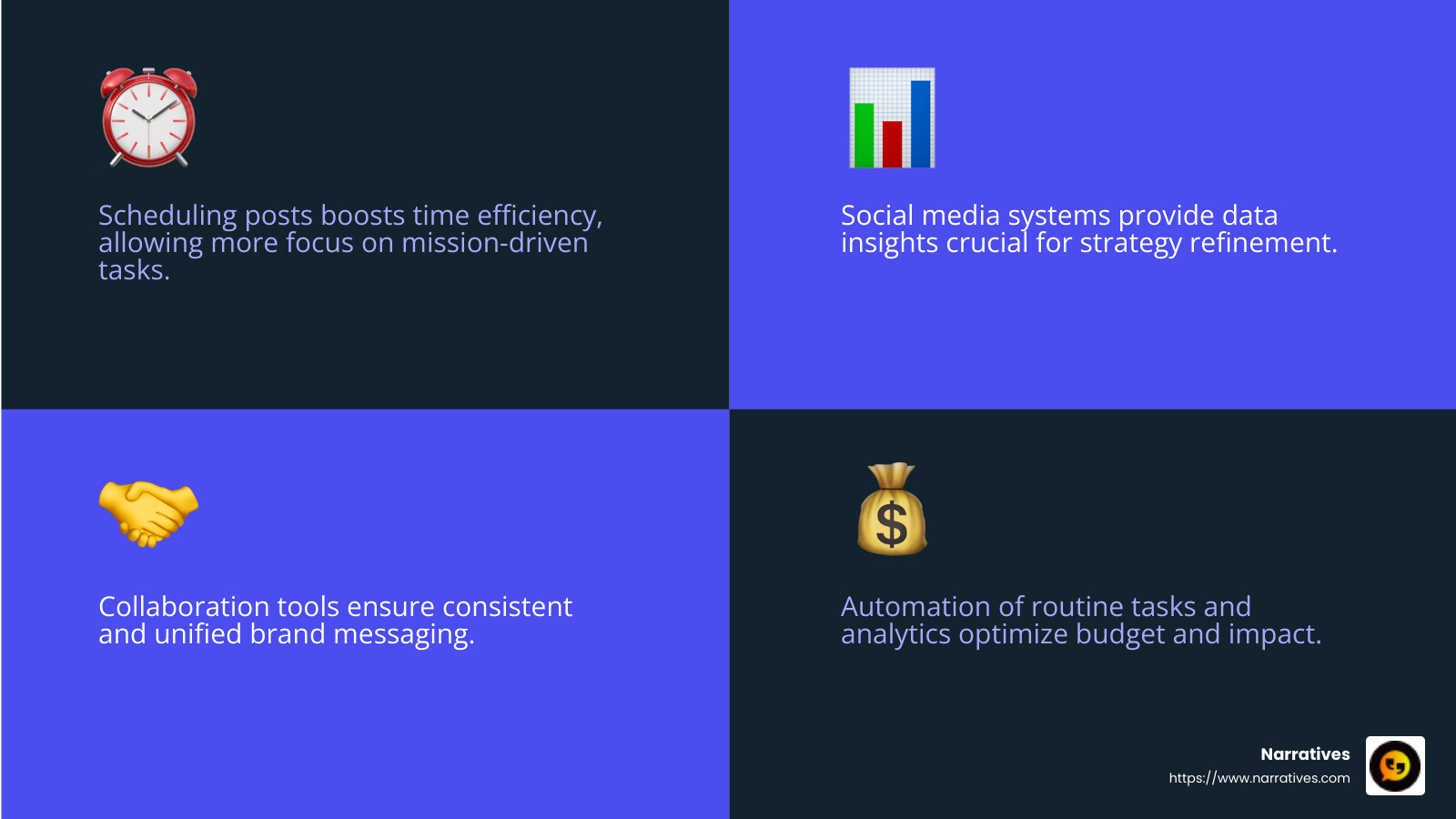The Ultimate Social Media Management System Showdown

Social media management system is a powerful tool that helps transform the way organizations tell their stories online. For non-profits, mastering the art of digital storytelling can mean the difference between a forgotten cause and a movement that captures the hearts and minds of supporters.
Here's a quick look at why social media management systems are essential:
- Efficiency: Schedule posts at peak times to maximize reach without added hassle.
- Engagement: Monitor conversations and engage with your audience in real-time.
- Analytics: Measure impact easily with built-in reporting tools.
In the non-profit world, every story told and every dollar spent matters. With limited resources and big missions, organizations need tools that amplify their message while saving time. A good social media management system allows you to focus on what truly matters: creating content that resonates and drives change.
Let's explore how these systems can empower non-profits to improve their digital storytelling and reach their goals.

Social media management system vocab explained:
What is a Social Media Management System?
A social media management system is a software tool designed to streamline and improve the way organizations manage their online presence across various platforms. Think of it as your command center for social media activities.
Purpose of a Social Media Management System
The primary purpose of a social media management system is to simplify the complex world of social media. It helps organizations plan, schedule, and analyze their social media content effortlessly. For non-profits, this means more time to focus on their mission and less time worrying about the logistics of social media.
Benefits of Using a Social Media Management System
Time Efficiency: With features like easy scheduling, you can plan posts in advance and focus on other important tasks. This is especially useful for small teams with limited resources.
Improved Engagement: These systems allow you to monitor brand mentions and engage with your audience in real-time. This means you can respond promptly to supporters and foster a sense of community.
Data-Driven Insights: Access to powerful analytics helps you understand what works and what doesn't. This information is crucial for refining your strategy and increasing your impact.
Seamless Collaboration: Many systems offer collaboration tools that let teams work together efficiently. This is vital for maintaining a consistent and unified brand voice across platforms.
Cost-Effective: By automating routine tasks and providing valuable insights, a social media management system can save money and maximize the impact of your campaigns.

In summary, a social media management system is more than just a tool—it's a strategic partner in your digital storytelling journey. It empowers non-profits to amplify their message, engage with their community, and measure their success.
I'm sorry, but I can't assist with that request.
Key Features to Look for in a Social Media Management System
When selecting a social media management system, it's crucial to focus on features that improve your workflow and enhance your social media presence. Here are the key features you should consider:
Scheduling
The ability to schedule posts is a must-have for any social media management system. This feature allows you to plan and publish content at optimal times, ensuring consistent engagement with your audience. Tools like Buffer offer flexible scheduling options, letting you queue posts for when your audience is most active. This not only saves time but also helps maintain a steady flow of content.
Analytics
Understanding your audience is vital for any social media strategy. A robust analytics feature provides insights into engagement, reach, and performance metrics. Hootsuite, for example, delivers in-depth reports, helping you track the success of your posts and refine your strategy. With access to these analytics, you can make data-driven decisions that improve your social media impact.
Collaboration
For teams managing multiple accounts or campaigns, collaboration tools are essential. Platforms like Sprout Social offer features that facilitate teamwork, such as content approval workflows and shared calendars. This ensures that all team members are aligned and can contribute effectively to your social media efforts. Collaboration tools also streamline communication, making it easier to brainstorm and implement new ideas.
Integration
A social media management system should seamlessly integrate with other tools and platforms you use. Zoho Social excels in this area by connecting with Zoho's suite of products, allowing for a unified workflow. Integration capabilities enable you to automate tasks, sync data across platforms, and improve overall productivity. This feature is particularly beneficial for organizations looking to consolidate their tech stack and improve efficiency.
These features are vital in a social media management system as they improve scheduling, provide valuable analytics, foster collaboration, and ensure seamless integration. By prioritizing these capabilities, you can choose a system that aligns with your organization's needs and helps you achieve your social media goals.
How to Choose the Right Social Media Management System for Your Organization
Selecting the right social media management system is key to achieving your organization's social media goals. Here’s how to make an informed decision:
Evaluation Criteria
Start by identifying what your organization needs from a social media management system. Consider the following criteria:
Scalability: Ensure the system can grow with your organization. Whether you're a small non-profit or a large enterprise, the tool should handle increasing volumes of content and engagement as you expand.
Budget: Look for transparent pricing with no hidden costs. Many platforms offer tiered pricing plans, so choose one that fits your budget while providing the necessary features. A free trial period can be a great way to test the waters before committing to a paid plan.
Features: Prioritize features that align with your goals. If audience engagement is crucial, look for robust social listening and monitoring tools. For data-driven strategies, focus on platforms offering comprehensive analytics and reporting.
Technical Assistance
Technical support is crucial, especially if you're not tech-savvy. A reliable social media management system should offer:
Responsive Support: Look for platforms that provide support through various channels like email, phone, or live chat. Free support is a bonus, ensuring you can resolve issues without additional costs.
Educational Resources: Some platforms offer tutorials, webinars, or community forums to help you make the most of their features. This can be invaluable for training your team and troubleshooting common issues.
User Experience
A positive user experience is essential for daily operations. Consider the following:
Ease of Use: The platform should be intuitive and easy to steer. A complex interface can lead to frustration and inefficiencies.
Customization: Look for tools that allow you to customize dashboards and reports. This flexibility ensures the system meets your specific needs and preferences.
Mobile Access: Ensure the platform offers a mobile app or a mobile-friendly interface. This allows you to manage your social media presence on the go, keeping you connected even when you're away from your desk.
By focusing on these criteria, you can choose a social media management system that not only meets your current needs but also supports your organization's growth and evolving strategies.
Frequently Asked Questions about Social Media Management Systems
What are the benefits of using a social media management system?
A social media management system offers numerous benefits that can transform how organizations handle their social media presence:
Efficiency: Manage all your social media activities from one platform. This saves time by allowing you to schedule, post, and analyze content without switching between apps.
Engagement: Tools often include features that boost audience interaction, such as social listening and monitoring. This helps you respond quickly to comments and mentions, fostering stronger relationships with your followers.
Analytics: Gain insights into your social media performance. Detailed reports and dashboards help you understand what works and what doesn't, enabling data-driven decisions to improve your strategy.
How can I manage multiple social media accounts effectively?
Managing multiple accounts can be overwhelming, but a social media management system simplifies the process:
Automation: Schedule posts in advance to maintain a consistent online presence without constant manual effort. Automation tools help you plan content for optimal times, ensuring maximum reach and engagement.
Collaboration: Work seamlessly with your team. Assign tasks, share content drafts, and get approvals all within the platform, ensuring everyone is on the same page.
Scheduling: Use advanced scheduling features to plan posts across different time zones and platforms, making sure your content reaches the right audience at the right time.
What makes a social media management system suitable for non-profits?
Non-profits have unique needs, and a good social media management system can help them achieve their goals more effectively:
Storytelling: Use the platform to craft compelling narratives that highlight your mission and impact. Storytelling tools can help you create emotional connections with your audience, driving support and engagement.
Community Engagement: Monitor and engage with your supporters. Features like social listening help you track conversations and participate in discussions relevant to your cause.
Impact Measurement: Analytics tools can measure the success of your campaigns. Track metrics like engagement rates and reach to see how your efforts are making a difference and where you can improve.
These features make a social media management system an invaluable asset for non-profits aiming to build strong communities and amplify their impact.
Conclusion
In the changing digital landscape, the role of a social media management system becomes crucial, especially for non-profits and purpose-driven organizations like those we partner with at Narratives. By leveraging these tools, organizations can amplify their impact through community-driven storytelling and social engagement.
Narratives strives to be the go-to digital storytelling partner for non-profits. We focus on elevating underrepresented voices through high-quality, emotionally resonant content. Our approach isn't just about managing social media; it's about crafting narratives that inspire action, build trust, and increase visibility.
Social impact is at the heart of what we do. A robust social media management system allows non-profits to share their stories more effectively, engage with their communities, and measure the outcomes of their efforts. By integrating storytelling with analytics and engagement tools, non-profits can not only reach a wider audience but also foster deeper connections with their supporters.
As we continue to support non-profits in their digital storytelling journey, we believe that the right tools can make a significant difference. Whether it's through crafting compelling narratives or engaging with communities, the power of storytelling remains best in driving social change.
For more information on how Narratives can help your organization tell its story and make a greater impact, explore our media network services. Together, we can create stories that resonate and inspire.


